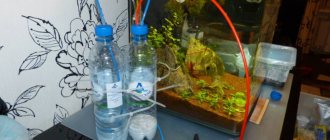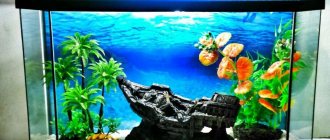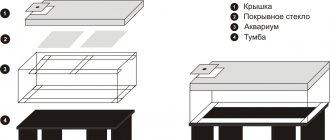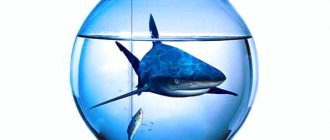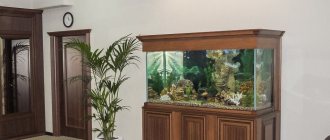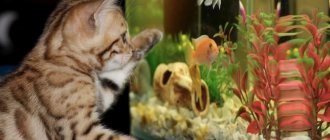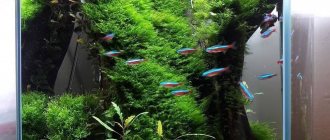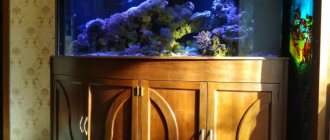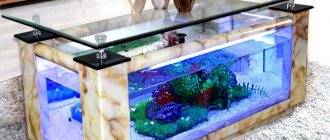4.7
(11)
It’s hard to imagine an amazingly beautiful, enchanting underwater world with marvelous inhabitants without plants. They serve as a shelter for fish, visually create three-dimensional space and, of course, immerse the aquarist in the world of creativity and creation.
Historically, there has been a stereotype about the impossibility of creating a fascinating underwater kingdom without the use of living vegetation. Artificial plants for the aquarium, which appeared in a huge assortment, gave impetus to the implementation of new ideas in design. And also provoked an endless debate “for” or “against”.
Lovers of all living things are trying to prove that artificial plants are harmful, and the selection of fertilizers and the sight of overgrown living plants gives no less pleasure than raising fish. Proponents of plastic and silk talk about the practicality, freshness and ease of maintaining artificial plants. A fan of African cichlids with an “African desert” design will shrug their shoulders at this debate.
But each of them will remain with his own opinion and will be right. The best plants are those that are planted with love, and the best aquariums are those that have a lot of soul put into their design. Despite standards and myths.
Advantages and disadvantages of artificial flora
Many aquarists mistakenly believe that without living flora a pond will not function normally, but this is not entirely true. Living aquarium plants produce oxygen, which is so necessary for the life of many phenotypes, but in the absence of flora, an aerator and air stones are quite capable of handling this responsibility, so now owners of reservoirs are increasingly giving preference to algae made from high-quality material - polyamide. It is so harmless and environmentally friendly that blood vessels for the human body are made from it. Artificial plants for an aquarium have many advantages, among which the most significant are:
- Durability - with good care and careful handling, artificial underwater flowers can delight the owner for 6-7 years. Such a plant does not rot, it is not bothered by natural wear and tear, and, in addition, the flower is very difficult to damage.
- Easy to maintain - to maintain its beauty, the artificial aquarium plant can simply be cleaned under running water. It does not require fertilizers, fertilizing, removal of overgrown parts and creation of the necessary water levels.
- Economical - polyamide vegetation will cost much less than buying and caring for living flora. In addition, you can purchase copies of exotic and rare species, which will be no different from the real ones, and cost several times less.
- Beauty and accessibility - the choice of artificial plants is huge, and in stores you can buy a flower of any shape and color. This allows you not to limit the aquarist’s imagination and create any design of the reservoir by choosing different decorations for the aquarium.
- Convenience - artificial aquarium flora allows you to change the composition of the tank in a matter of time, since the plants can be moved and changed without causing damage.
- Inedibility – algae-eating fish cannot eat an aquarium artificial flower, so you don’t have to worry about the safety of the flora.
- Insensitivity – polyamide vegetation for aquariums is resistant to medications, so you can safely treat fish.
However, in addition to an impressive list of advantages, artificial plants also have disadvantages:
- An aquarium with artificial plants will need to be equipped with aeration, since non-living flora is not capable of creating an ecosystem in a reservoir and saturating the water with oxygen.
- Plants made from non-natural silk or polyamide cannot clean aquariums of nitrates and other fish waste, so a good filter is required in the tank.
- Stagnant zones in aquariums - the occurrence of zones is inevitable, since artificial flowers do not have roots.
- Causing injury to fish - when buying cheap flowers with sharp leaves, fish may get injured on the edges. It is worth noting that high-quality flora made of silk or polyamide does not belong to such colors.
- Algae Development – Over time, tiny algae will inevitably form on a non-living plant. Getting rid of them is simple: just wash the flower using disinfectants.
Separately, mention should be made of the toxicity of the materials used to make algae. Many aquarists believe that immersing artificial plants is dangerous to the health of fish and shellfish, since toxic materials that are stained are used in production. This is true: cheap types of flora are made of harmful materials, but this does not apply to high-quality plants made of artificial silk or polyamide. Therefore, you should purchase flora for aquariums only in trusted stores, and also check the flower at home for coloring.
Pros and cons of artificial decorations
After several years of use, artificial plants, with minimal care, will retain their pristine freshness and beauty. In this case, the brightness of the lighting, temperature and other parameters of the water are not important. Living inhabitants will not gnaw off the leaves and will not spoil the roots of the plant. There is no need to look for suitable fertilizers, replant and thin out.
When using artificial decoration, the likelihood of introducing insect larvae or pathogenic microorganisms into the “jar” is minimal. At the same time, you don’t have to worry about thickets when treating fish, for example, with antibiotics.
Plants made of plastic or silk can be planted even in cichlids, without worrying that they will be broken, dug up or eaten by voracious inhabitants in a short time.
It is very easy to give the desired shape when decorating with artificial plants using scissors. Plastic copies of exotic plants, the cultivation of which is a very long and labor-intensive process, are ultimately much cheaper than living originals.
All of these are advantages, but there are also disadvantages to consider. These include the fact that sooner or later plastic plants will fade and need to be replaced. Moreover, silk plants will have to be changed more often, as they quickly lose their visual appeal.
Fish swimming in the thickets can cut themselves on low-quality plastic. You should take a more careful approach to the issue of filtration and saturation of water with oxygen, since artificial plants are useless in this regard.
With living plantings, there is a high probability of natural bioequilibrium occurring in the aquarium. Also, many fish use live plants for spawning and diversify their diet with them.
How to check the quality of the dye
Low-quality plants, when immersed in liquid, emit harmful substances and dyes, so experienced pond owners recommend first checking the quality of an artificial aquarium flower with cleaning agents.
How to try an artificial plant:
- First, prepare a solution: white is mixed with water in a ratio of 1:9. The amount of solution should be enough so that the object is completely immersed in the liquid.
- The algae is dipped into the solution and left for 15–20 minutes. If the color has not changed during this time, then the quality of the paint is good and the flower will not harm the fish.
- After checking, the plant is placed in ordinary water for 15 minutes, and then rinsed thoroughly under running water.
Attention: artificial silk plants cannot be treated with bleach!
Caring for artificial flora
Despite being lightweight and durable, aquariums with artificial flora also require a little maintenance. Tiny algae accumulate on non-living plants, forming plaque, so you need to know how to clean dirt from flowers. There are two ways to clean unnatural flowers:
- Boiling water - when immersed in boiling water, the smallest bacteria are killed, but the method will be effective if the plant is not heavily contaminated. To remove microflora, the decor item is boiled for 10 minutes, and then all surfaces of the flower are cleaned with a soft brush.
- Whiteness - a solution with whiteness can kill almost all bacteria in a short time. Decorative elements are placed in the solution (ratio of product to water 1:9) for 10 minutes and then washed under running water.
Plants made from silk are cleaned differently as boiling water or bleach will ruin the look. The flower is washed under hot running water, and then carefully cleaned with a paste of rock salt and lemon juice, rinsed thoroughly and dried.
Rules for designing an aquarium
In order for artificial plants to look organic in an aquarium, they must be placed taking into account certain rules:
- Equipment camouflage. Such products are well suited for hiding equipment that disrupts the natural appearance of the underwater landscape. To do this, it is necessary to use tall and long specimens, placing them next to the devices so that the thick leaves hide the equipment from view.
- It is best to make the back wall of the aquarium neutral or dark, then attention will not switch from the plant composition to the background. The color depends on what color the plants are. If the composition is replete with different colors, then a light, neutral background will look more advantageous, and a dark one will be suitable if the plants are predominantly monochromatic, for example, light green.
- It is also best to choose a neutral shade of primer - light gray or beige. Small pebbles or sand are quite suitable. You can also use dull shells.
- If the soil is poured in layers of decreasing thickness towards the back, then the impression of perspective can be achieved. A more impressive layer of soil is poured closest to the front wall, and towards the rear wall the thickness of the layer can decrease by 2-3 times.
- Approximately in the middle of the container, in its central part, at the bottom you can place spray stones (aeration stones) that release air bubbles. These bubbles will enliven the underwater world, draw attention to design elements and enrich aquatic organisms with oxygen.
- Medium-sized plants, such as Amazons, are usually placed in the center of the aquarium.
Ideally, the height of the plant reaches approximately 1/3 of the container. This algae will be the basis of the composition, so it is worth paying attention to the choice of plant, its size and color. The tallest plants are best placed at the back, close to the background. - To focus attention on the central plant of the composition, you should place driftwood, stones, and shells next to it. It is not recommended to use other types of plastic products (for example, a sunken galleon), as they will destroy the entire organic design. Around this area you can “plant” small algae and small bushes that will not block the visibility of the central part.
- You can leave an empty space near the front wall or “plant” it with small specimens. It is important that they do not distract attention and make the rest of the aquarium visible. Dense thickets may be located near the side walls and in the background.
- To make your aquarium design look more interesting, do not use plants of only one type, color and size. But don’t try to “shove” into the aquarium all the variety of plastic products that are available in pet stores. It is best to choose 3 types of plants, 2 of which will be similar in color, and the color of the third will be different. Each type may have its own size.
- When placing plants, do not strive for geometric accuracy. Try to avoid straight lines, correct quantitative ratios, and do not plant products in one row. There is always a slight negligence in nature.
- You can also experiment with lighting. Artificial flora does not need bright light; moreover, under too bright and prolonged lighting, the products will begin to fade faster. Therefore, you can limit yourself to only the light that is necessary for the underwater inhabitants, and not all fish need daylight. In addition to brightness, you can also experiment with lighting colors - blue, pink, greenish.
These are the basic tips for decorating an aquarium. For the rest, don’t be afraid to show your imagination. After all, the advantage of artificial algae is that they can always be moved, forming new compositions.
DIY artificial plant
You can build an unnatural flower for an aquarium with your own hands in 15 minutes. Of course, it will not be as skillfully made as store-bought seaweed, but it will be one of a kind and will add originality to the pond. You can show off your own aquarium to your friends and acquaintances.
To make it you will need:
- a piece of foam;
- skein of green yarn;
- piece of hard cardboard;
- medium size stone.
Creation method:
- A square of cardboard is cut on both sides, and green yarn is wound around the cuts.
- After making 50 turns, the end of the yarn is tied, making a loop like a tie.
- The side opposite the loop is cut and the cardboard is thrown away.
- Styrofoam is attached to the site of the knot so that the algae floats, or a stone so that it sinks.
- Do-it-yourself algae for an aquarium is ready.
Artificial plants for aquariums have a lot of advantages, and every year they are gaining popularity among pond owners. In addition to durability and easy care, non-natural flora looks great and allows you to create exotic aquarium designs.
